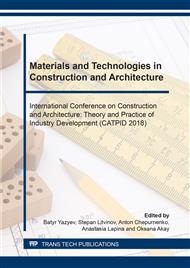[1]
M.E. Berlyand, Modern problems of atmospheric diffusion and air pollution, Leningrad, Hydrometeoizdat, (1975).
Google Scholar
[2]
M.E. Berlyand, Prediction and control of atmospheric pollution, Leningrad, Hydrometeoizdat, (1985).
Google Scholar
[3]
Methods of calculation of concentrations in atmospheric air of harmful substances contained in emissions of enterprises, OND-86, Leningrad, Hydrometeoizdat, (1987).
Google Scholar
[4]
F.Ya. Rovinsky, S.A. Gromov, L.V. Burtseva, S.G. Paramonov, Heavy metals: long-range transport in the atmosphere and falling with precipitation, Meteorology and Hydrology, 10 (1994) 5-14.
Google Scholar
[5]
Yu.A. Izrael, Ecology and control of natural environment, Moscow, Gidrometeoizdat, (1984).
Google Scholar
[6]
A.M. Vladimirov, Y.I. Lyakhin, L.T. Matveev, V.T. Orlov, Environmental Protection, Leningrad, Hydrometeoizdat, (1991).
Google Scholar
[7]
E.N. Teverovsky, E.S. Dmitriev, Transfer of aerosol particles by turbulent flows, Moscow, Energoatomizdat, (1988).
Google Scholar
[8]
G.I. Marchuk, Mathematical modeling in the problem of environmental protection, Moscow, Science, (1982).
Google Scholar
[9]
A.E. Aloyan, V.V. Penenko, V.V. Kozoderov, Mathematical modeling in environmental problem. Modern problems of computational mathematics and mathematical modeling, Mathematical modeling. 2 (2005) 279-351.
Google Scholar
[10]
V.K. Arguchintsev, A.V. Arguchintseva, Modeling of mesoscale hydrothermodynamic processes and transfer of anthropogenic impurities in the atmosphere and hydrosphere of lake Baikal – Irkutsk region, Irkut. state University, (2007).
Google Scholar
[11]
G. Fellenberg, Pollution of the natural environment. Introduction to environmental chemistry: Per. him., Moscow, Mir, (1997).
Google Scholar
[12]
A.V. Shapovalov, V.A. Shapovalov, Three-Dimensional visualization of geophysical data for solving applied problems, Science. Innovations. Technologies, 1(5) (2014) 65-73.
Google Scholar
[13]
A. M. Kerimov, E.A. Korchagina, A.V. Shapovalov, V.A. Shapovalov, Models and methods to calculate the mesoscale distribution of impurities in the atmosphere, Nalchik, KBSC of RAS, (2008).
Google Scholar
[14]
V.I. Ryazanov, A.V. Shapovalov, V.A. Shapovalov, Modeling of impurities propagation in the atmosphere taking into account local meteorological conditions, in: Proceedings of the High-Mountain Geophysical Institute, Ufa, 2017, pp.17-23.
DOI: 10.1007/s10958-021-05253-1
Google Scholar
[15]
A.V. Shapovalov, V.A. Shapovalov, V.I. Ryazanov, A.V. Shapovalov, Mathematical model of propagation of impurities in the near zone during rocket engines, Science. Innovations. Technologies. 2 (2017) 87-96.
Google Scholar
[16]
J.K. Angell, Measurements of Lagrangian and Eulerian properties of turbulence at a height of 2 to 500 ft, Quart. J. Roy. Meteorol. Soc. 90(383) (1964) 57-71.
DOI: 10.1002/qj.49709038306
Google Scholar
[17]
A. Longhetto, P. Gulliot, D. Anfossi et al. Atmospheric dispersion experiments in the near and medium field, Nuovo Cimento. 5(3) (1982) 299-331.
DOI: 10.1007/bf02509143
Google Scholar
[18]
P.H. Gudiksen, M.H. Dickerson, R. Lange, J.B. Knox, Atmospheric field experiments for evaluating pollutant transport and dispersion in complex terrain, Air Pollution Modelling and Applications, Proceedings of the 14th Int. Techn. Meet. New York, London. 4 (1985).
DOI: 10.1007/978-1-4613-2455-3_26
Google Scholar
[19]
D.J. Szepesi, Multiple-source model for air pollution forecasting. Air Pollution Forecasting, Pap. WMO RA-VI Meeting. (1984) 28-37.
Google Scholar
[20]
Information on https://www.ncdc.noaa.gov/data-access/model-data/model-datasets/global-forcast-system-gfs.
Google Scholar
[21]
V.S. Efremov, B.M. Vovshin, I.S. Vylegzhanin, V.V. Lavrukevich, R.M. Sedletskiy, Polarization Doppler meteorological radar with compression of pulses, Journal of radio electronics. 10 (2009).
Google Scholar


